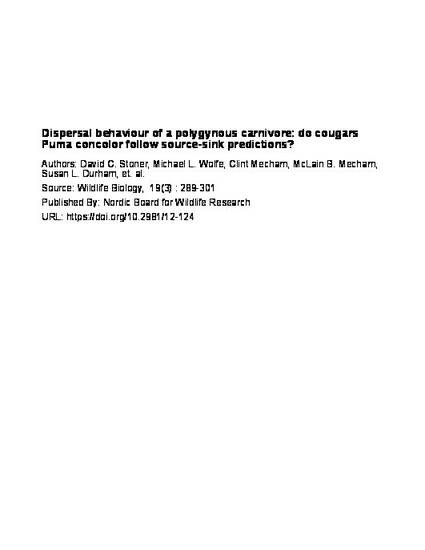
The source-sink model of population dynamics predicts that density drives emigration of subordinate animals to habitats offering lower competition for resources. Several authors have suggested use of this model as a potential framework for conservation of exploited carnivores when precise enumeration is unfeasible. Dispersal is a critical behavioural mechanism for management based on this model, yet there is a lack of knowledge on the habitat and social conditions that motivate carnivore emigration and settlement. The cougar Puma concolor is a widely distributed and heavily exploited carnivore, indigenous to the western hemisphere. We evaluated patterns in cougar dispersal behaviour from two sites in Utah, differing in terms of management and the level of natural and anthropogenic habitat fragmentation. We used our results to evaluate three predictions with respect to cougar dispersal behaviour: 1) natal population density and maternal reproductive status prompt emigration, 2) movement of dispersing cougars is shaped by habitat configuration and permeability, and 3) dispersers preferentially settle in areas of high habitat quality and low conspecific density. We documented the emigration of 62 individuals and measured movement variables, including sex and site-specific frequency, distance, seasonality, direction and the habitat quality and harvest rates characterizing areas where immigrants settled. Although males and females exhibited pronounced differences in dispersal frequency, we found few differences in distance traveled, season of departure and direction moved. Dispersal occurred most frequently during spring, coinciding with the estrus pulse. Natural and anthropogenic obstacles modified landscape permeability, and therefore dispersal distances were shorter in fragmented habitats than in contiguous ones. Relative to males, females dispersed into habitats of lower productivity with higher mean annual harvest rates. Patterns in male settlement suggested habitat selection based on mating opportunities, whereas female settlement was predicated on avoiding conspecifics. Cougars in this Great Basin ecosystem largely conformed to source-sink predictions. Results can be used to parameterize source-sink models based on animal behaviour and landscape permeability to conserve exploited carnivores, under conditions of population expansion or recolonization of habitats where Allee effects are a limiting factor.
